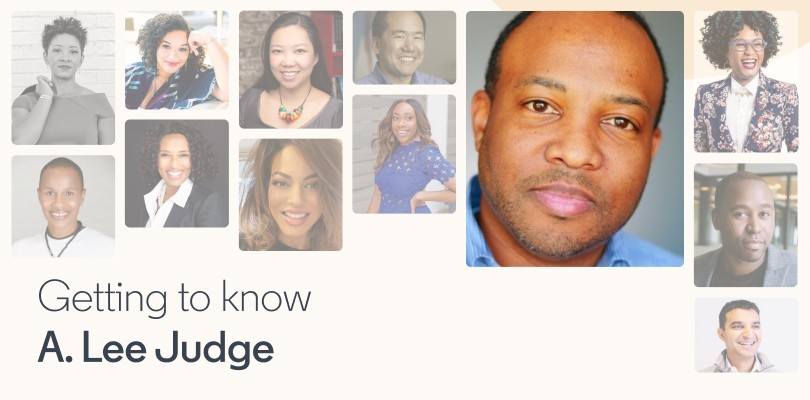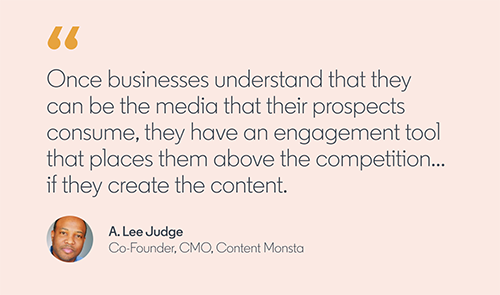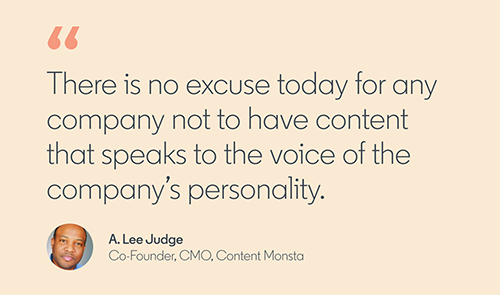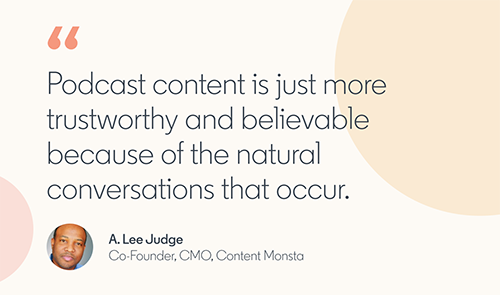A. Lee Judge: Be in the Room Where It Happens
Traditional push marketing techniques are relics of a bygone era. A. Lee Judge recognizes this, and he’s doing something about it.
“We can’t simply force people to listen to our ads and videos about products,” he wrote last year in an article on LinkedIn. “Aggressive ad campaigns tend to form a strong aversion in more sensitive members of the audience.”
He added: “People despise being sold to, but they love entertaining, engaging content.”
Coming from a background in media production, Lee is perfectly suited to help usher in a new age of digital marketing that scales back the selling, and places entertainment and engagement at the forefront. He is doing so as co-founder and CMO of Content Monsta, a shop specializing in scalable multimedia content.
Lee is a frequent contributor to Forbes (he recently published there about the goals and purpose of a business podcast), and his active social media presence makes him very much a marketer worth following on LinkedIn.
We recently asked Lee about his guiding philosophies, his vision for content marketing’s path forward, where he’s seeing prevalent gaps in modern strategies, and more.
LinkedIn: Tell us a little about your company Content Monsta. Why'd you start it, and what are the philosophies that drive it?
A. Lee Judge: Content Monsta started when I was a Marketing Director with a small team that needed to create more business-driving content. We needed video and well-targeted written content especially. My background is in media production, so I took it on myself to create a video series for the company I worked for. That series prompted other companies to ask me for the same kind of content. That was the spark that started Content Monsta.
Our goal is to help small marketing departments make big impacts. Our philosophy is that every company should be a media company within their industry. Content Monsta can create that media for them and back it with a digital marketing strategy.
LI: Given your background in media production, what do you see as the most promising ways to engage and entertain B2B audiences at a time where live-streaming, social media stories, audio-based apps, and so forth are growing rapidly?
Lee: Once businesses understand that they can be the media that their prospects consume, they have an engagement tool that places them above the competition... if they create the content. The fact that media can be created faster and in real-time scares many companies with thoughts of losing control. That fear slows them down to a point where they can easily be silenced by the competition. Weeks or months of approval cycles can be debilitating to a company that is hoping to stay top of mind. Companies must learn to create content faster and more efficiently.
LI: What is the most prominent disconnect you see between sales and marketing departments, and how can technology help solve it?
Lee: The most prominent disconnect I see between sales and marketing departments is the ability to understand each other’s needs and how their success depends on the success of the other. It’s like the offense and defense of the same team; they don’t play against each other because they have the same goal. Marketing doesn’t pay enough attention to creating the right content to assist Sales, and Sales isn’t willing to help gather the data that marketing needs to provide the best prospects.
Technology isn’t always the answer to solving this disconnect. Most organizations already have the technology that they need; however, the human activity to feed that technology is where we lack.
LI: You had a great post on LinkedIn recently where you argued, "Some of the best parts of marketing aren’t measurable." With that sentiment in mind, how should modern marketers be assessing and evaluating their strategies through a full-funnel scope?
Lee: Marketers must keep in mind that it is equally important to execute on measurable activities as those that we simply know have impact but cannot measure. For measurable activities, make sure that the measurement tracks all the way to the bottom line to impact business. Marketing must show value at that level.
At the same time, if educating our customers, staying top-of-mind, and being present when opportunities arise are not measurable, we cannot stop doing these activities just because the numbers aren’t there. If you are not in “the room where it happens” then you will have nothing to measure when it happens.
LI: Many brands are taking a greater interest in executive thought leadership, and that's an area where your social presence is exemplary. How do you recommend using LinkedIn to elevate and strengthen the voices of company leadership?
Lee: There is no excuse today for any company not to have content that speaks to the voice of the company’s personality. I don’t mean over-polished, over-scripted, commercials or HR reels either. I mean day-to-day examples of individuals (executive and front line) sharing their experience and expertise that gives prospects a feeling that they know the company. This builds trust and more importantly builds a feeling of connection to the brand.
LI: The last year has obviously been a turbulent one for society, with COVID lockdowns and civil unrest stemming from George Floyd's killing. What do you view as the biggest challenges, changes, or lessons of the past 12 months from a marketing standpoint?
Lee: The biggest challenge that I’ve seen companies face over the past year has been trying to figure out how to do the same marketing, but in a different way. Instead they should learn to do different marketing – the new way. We aren’t going back to pre-COVID in regard to what or how we do marketing. Instead of thinking “how do we do what we did before, but virtually” we should think “what new ways can we market now that work moving forward.”
LI: What content is giving you life? (Or, what's the most impactful/memorable piece of content you've encountered recently?)
Lee: Lately I’ve consumed a lot of podcast content. Not only because I listen to our clients’ content, but because podcasts tend to be more conversational and less scripted. You get to hear an individual’s thoughts rather than a script that was poured over by marketing, management, and legal. Podcast content is just more trustworthy and believable because of the natural conversations that occur.
LI: What's something a business colleague or peer in the industry did over the past year that helped or inspired you? (Maybe they're not even aware of it?)
Lee: I have a couple of industry peers that inspire me with their ability to show up consistently and deliver when the quality is “good enough.” It’s hard for anyone not to get analysis paralysis when they seek to deliver value with a high level of quality. But I’m inspired by peers who deliver when it’s time to deliver and don’t let quality hinder their quantity. After all, while quality is the goal, quantity and consistency are the drivers that keep you top-of-mind.
LI: Any final thoughts?
Lee: I encourage brands to show up in the most natural way that they can. Consumers are tired of the overly polished business facades and want to know the people and the experiences behind the brand. Develop relationships, bring value, and let your audience know who to trust when they need a solution or product. The business will follow.
Is your LinkedIn feed feeling stagnant these days? Follow these 16 brilliant thinkers to add new voices. And to keep abreast of the latest marketing trends, subscribe to the LinkedIn Marketing Solutions blog.
Topics: Diversity Skill building and careers
Related articles







